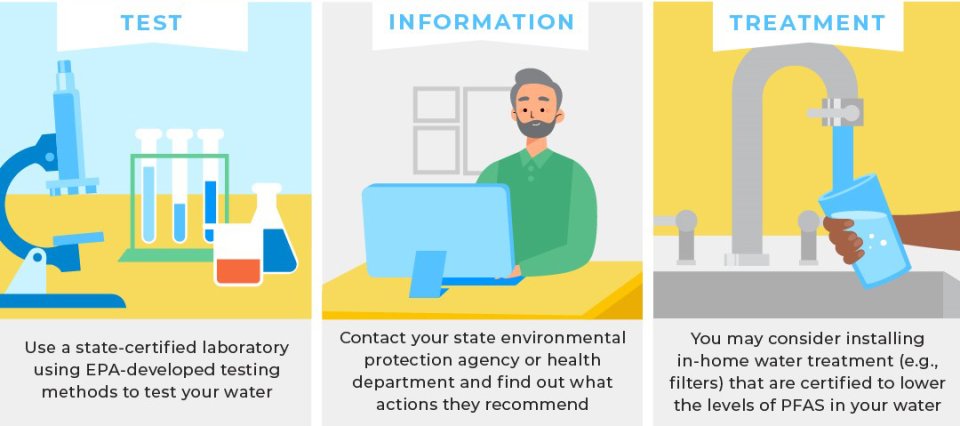PFAS in Private Wells

What are PFAS?
Per- and polyfluoroalkyl substances (PFAS) are manufactured chemicals that have been used in industry and consumer products since the 1940s. Because of their widespread use and their persistence in the environment, many PFAS are found in the blood of people and animals all over the world.
What does it mean if PFAS levels in my private well are above the federal drinking water standards?
It is important to note that consuming water with PFAS levels above the federal standard does not necessarily mean that adverse health effects will occur. The degree of risk from PFAS exposure depends on many factors including:
- Level of the chemicals
- How much a person is exposed and how long they're exposed over time
- Individual factors (like genetics and lifestyle)
Researchers are working to better understand how toxic or harmful PFAS are to people and the environment. If your water has been found to have PFAS and you have specific health concerns, you may wish to consult with your doctor.
How can I reduce my overall exposure?
Drinking water is only one possible source of PFAS. Even though recent efforts to remove certain PFAS from commercial goods have reduced the likelihood of exposure, some household products and indoor air or dust may still contain PFAS. Possible sources can be:
- Drinking water (filter info (pdf) )
- Contaminated waste sites
- Fire extinguishing foam
- Manufacturing facility waste
- Consumer products (floss, cosmetics, cleaning products, etc.)
- Food packaging
- Biosolids (recycled sewage used as soil)
- Exposed fish, dairy, meat, and/or vegetables
To reduce exposure, look for PFAS-free labeling and review product Safety Data Sheets.
Avoid eating fish from waterways contaminated with PFAS. You can determine which waterways are of concern by contacting your state or tribal fish advisory programs using EPA's list of state, territory, and tribal fish advisory contacts.

What can I do about PFAS in my private well?
While the EPA does not regulate or provide recommended standards for private wells, there are still steps you can take.
-
Contact your state environmental or health agency for detailed advice about how to reduce PFAS exposure or to obtain a list of state-certified laboratories using EPA-developed testing methods in drinking water.
-
Consider installing an in-home water treatment system or filtered pitcher that is certified to lower the levels of PFAS in your water. Learn about certified in-home water treatment filters.
-
Consider using an alternate water source for drinking, preparing food, cooking, brushing teeth, preparing baby formula, and any other activity when your family might swallow water.
-
Continue regular well testing for overall quality of the water and whether it contains PFAS.
Find additional resources about private wells: www.epa.gov/privatewells
What can the EPA Superfund program do about PFAS in my private well?
The EPA's Superfund program may test private drinking water wells as part of our overall site investigation to determine where contamination is coming from, and if it is affecting people’s health. As part of this investigation, we may find levels of PFAS in private drinking water wells. If PFAS levels are high enough, EPA may be able to provide a temporary alternative source of drinking water until we can determine if the PFAS contamination is caused by the Superfund site.
Because PFAS contamination is so widespread in the environment, it's possible that the PFAS in private wells originated from somewhere other than the Superfund site. In that case, EPA would not be allowed, by law, to spend Superfund dollars to address the PFAS contamination. That’s why it's important for families to refer to the actions provided in this fact sheet to help reduce exposure to PFAS chemicals.
EPA will continue to keep the community informed about ongoing cleanup activities at your Superfund site. If you have any questions about PFAS sampling and private wells, please contact your Superfund Community Involvement Coordinator.
Additional resources:
Download a printable version of the fact sheet: PFAS in Private Wells (pdf)
